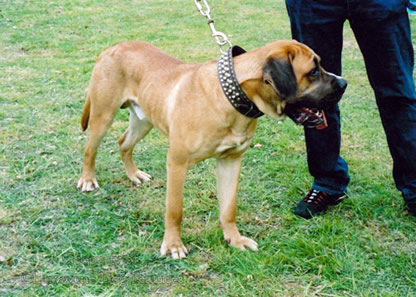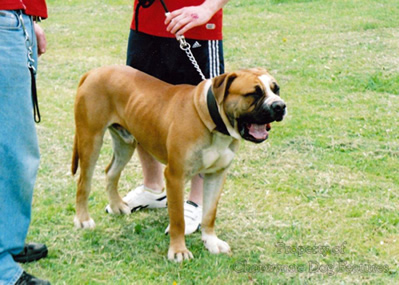466 Restoring the Mastiff
RESTORING A NATIONAL TREASURE
by David Hancock
"This island of England breeds very valiant creatures;
Their mastiffs are of unmatchable courage."
(Shakespeare's Henry V)
Freedom of choice underpins every democratic society but a wilful destruction of your own culture and heritage, in pursuit of this, is surely unwise. Our sporting heritage is part of our national culture and our native breeds of animal represent the legacy of a considerable breeding achievement. We used to have a high international rating both as sportsmen and livestock breeders. In the world of dogs, our reputation as breeders is slipping and our reputation as exaggerators growing. I am all in favour of fanciers being able to import outstanding dogs from abroad; that is a matter of choice. I am not in favour of our native breeds being not just neglected but bred harmfully to a 'new' design. Two of our native breeds especially now look nothing like their distant ancestors and these two breeds, the Bulldog and the Mastiff, are the essence of our canine heritage.
The lack of a function for these two distinguished breeds, allied to misguided show criteria and a closed gene pool, hasn't helped. Our Mastiff was once revered all over northern Europe as a hunting dog: the Englische Dogge. It was a heavily-muscled strong-headed active agile hound, used to close with quarry and seize it for the accompanying hunters. It was not a giant sloth but a powerful canine athlete. In the nineteenth century, in a misplaced desire for great size and immense bulk, breeders blended the blood of imported dogs such as Great Danes, Alpine Mastiffs and Tibetan Mastiffs to create the giant breed we have with us today. As a direct result we are left with a very different Englische Dogge, more a fawn Alpine Mastiff, and shame on us for that.
 If the will were there, it would not be difficult to re-create the classic Mastiff, the type portrayed by Ben Marshall two centuries ago. It would be a strapping dog, around 26-28 inches in shoulder height and around 110 pounds in weight. It could be any colour, not just fawn or brindle. It would be tight-eyed and tight-lipped, not a drooling monster with sagging eyelids. It would not be short-muzzled but broad-mouthed - and there is a difference! It would need the hindquarter angulation of a Foxhound, not the straight stifles of the show-ring Mastiff. It would be an imposing dog, one demanding respect. In past centuries a noble family or member of the landed gentry would have undertaken this restoration task, but not any more, they have long abandoned such roles. But their property still needs guarding, perhaps more than ever, and the mastiff instinct is 'reasonable force', i.e. pinning their quarry to the floor.
If the will were there, it would not be difficult to re-create the classic Mastiff, the type portrayed by Ben Marshall two centuries ago. It would be a strapping dog, around 26-28 inches in shoulder height and around 110 pounds in weight. It could be any colour, not just fawn or brindle. It would be tight-eyed and tight-lipped, not a drooling monster with sagging eyelids. It would not be short-muzzled but broad-mouthed - and there is a difference! It would need the hindquarter angulation of a Foxhound, not the straight stifles of the show-ring Mastiff. It would be an imposing dog, one demanding respect. In past centuries a noble family or member of the landed gentry would have undertaken this restoration task, but not any more, they have long abandoned such roles. But their property still needs guarding, perhaps more than ever, and the mastiff instinct is 'reasonable force', i.e. pinning their quarry to the floor.
The association between large and often imposing houses and large and equally imposing dogs is a long and varied one. In the days when the nobility of Europe prided themselves on their horses and dogs, many famous breeds owed their origin to the dedicated, almost single-minded patronage of landed families. The royalty and aristocracy of Europe liked to have their portraits painted with their mastiff-like dogs, as the Batoni portrait of Sir Harry Fetherstonhaugh, the Della portrait of Kaiser Ferdinand II, the Van Dyck portrait of the children of Charles I and the Velazquez painting of Las Meninas illustrate, the latter featuring a cropped-eared Spanish Mastiff, a breed still existing today. The inherited sense of sporting history in the blood of such dynasties so often led to the stables and kennels being a prized feature of the family property. The architectural importance of purpose-built kennels such as those at Croxteth Hall in Liverpool and Lyme Hall near Manchester is now acknowledged. The fact that so many of these kennels no longer have dogs in them is disappointing.
Lyme Hall retains paintings of its mastiffs; Chatsworth and Nostell Priory retain the collars of their mastiffs. But how comforting it would be to see this ancient association revived. The Lyme Hall kennels are now empty but their Danish equivalents may soon be filling up with the mastiffs of Broholm Castle or Broholmers, now thankfully being resurrected. The Belgian Mastiff, misused as a draught-dog, is currently being saved from the threat of extinction. Our own breed badly needs restoration and how good it would be to see these fine dogs back in favour at great houses, whether owned by princes or pop-stars.
Mastiffs, eminent owners and historic houses coincide again and again when the development of today's Mastiff breed is researched. We can read of the Earl of Oxford's 'Lion', the Marquis of Hertford's 'Pluto', Lord Waldegrave's 'Turk' and 'Couchez', Sir Fermor Hesketh's 'Nero', Sir George Armitage's 'Tiger' and Sir E. Wilmott's 'Lion'. As well as the celebrated Lyme Hall strain, we can discover an old line of pure Alpine mastiffs (probably smooth St.Bernards) at Chatsworth and references to mastiffs at Elvaston Castle near Derby, Hadzor Hall near Worcester, Trentham Park near Stoke on Trent, Bold Hall in Lancashire, Esthwaite Hall in the Lake District and Nostell Priory in Yorkshire, Lord Stanley's dogs at Alderley and Athrington Hall's 'Lion'. Mastiffs and mansions were clearly closely associated and those at Lyme Hall hardly unique.
I suspect that the separation of noble families from their mastiffs had multiple causes, with two world wars significant accelerators. But one rather sad reason could lie in the departure of the modern breed away from its historic mould as a heavy hound, used to pull down big game such as auroch, buffalo, boar and wild bull, and into a cumbersome unathletic overweight yard-dog. On this basis alone, I can understand any potential Mastiff owner, mansion-owner or not, looking elsewhere. More and more foreign mastiff breeds like the Dogue de Bordeaux and the Neapolitan Mastiff are finding favour here, with our native breed, now resembling the Alpine Mastiff used by nineteenth century breeders to reshape it, losing type. 
Nevertheless, the Mastiff, once a magnificent breed of imposing stature and impressive temperament, is an important feature of our canine heritage and it would be good to see a remodelled breed, physically respecting its own ancestry, gracing the steps of big houses once again. A hundred years ago, the Marquess of Londonderry and the Duke of Gloucester favoured the Bullmastiff, smaller and more athletic than their sister breed but strangely now being desired by some fanciers to be more mastiff-like. Fashion has destroyed more than one breed of dog. It would be heart-warming to see the real Mastiff of England favoured once again by country property-owners. This was a breed of reassuring solidity, with noble bearing, an air of relaxed superiority yet possessing impressive reliability. They had much in common with the great houses they once adorned and much to contribute to their protection. 
"He seems to be fully aware of the impression which his large size makes on every stranger; and, in the night especially, he watches the abode of his master with the completest vigilance..."
William Youatt, on the Mastiff, in his 'The Dog' of 1854.
"... there can be no doubt that these monarchs of strength and beauty will again become fashionable and find places in the stately halls of Great Britain and her dominions."
Frank Townend Barton, MRCVS, on the Mastiff, in his 'Non-Sporting Dogs' of 1905.